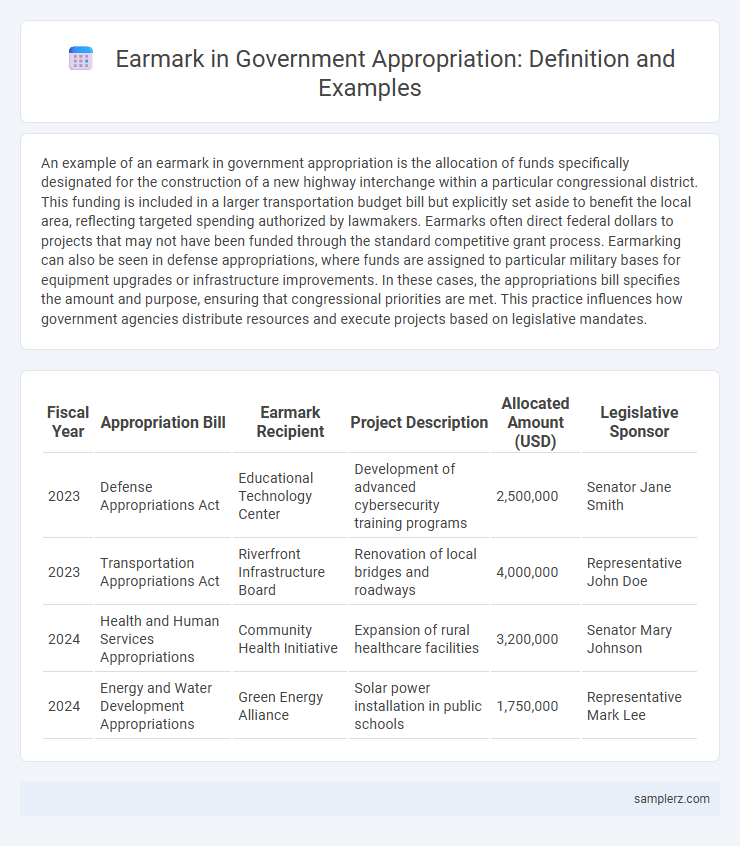An example of an earmark in government appropriation is the allocation of funds specifically designated for the construction of a new highway interchange within a particular congressional district. This funding is included in a larger transportation budget bill but explicitly set aside to benefit the local area, reflecting targeted spending authorized by lawmakers. Earmarks often direct federal dollars to projects that may not have been funded through the standard competitive grant process. Earmarking can also be seen in defense appropriations, where funds are assigned to particular military bases for equipment upgrades or infrastructure improvements. In these cases, the appropriations bill specifies the amount and purpose, ensuring that congressional priorities are met. This practice influences how government agencies distribute resources and execute projects based on legislative mandates.
Table of Comparison
| Fiscal Year | Appropriation Bill | Earmark Recipient | Project Description | Allocated Amount (USD) | Legislative Sponsor |
|---|---|---|---|---|---|
| 2023 | Defense Appropriations Act | Educational Technology Center | Development of advanced cybersecurity training programs | 2,500,000 | Senator Jane Smith |
| 2023 | Transportation Appropriations Act | Riverfront Infrastructure Board | Renovation of local bridges and roadways | 4,000,000 | Representative John Doe |
| 2024 | Health and Human Services Appropriations | Community Health Initiative | Expansion of rural healthcare facilities | 3,200,000 | Senator Mary Johnson |
| 2024 | Energy and Water Development Appropriations | Green Energy Alliance | Solar power installation in public schools | 1,750,000 | Representative Mark Lee |
Definition and Purpose of Earmarks in Appropriations
Earmarks in appropriations are provisions within federal budget bills that allocate funds for specific projects or purposes, often directed to particular congressional districts or states. These targeted funding provisions enable lawmakers to support local initiatives, infrastructure improvements, or community programs that might not receive direct funding through regular budget processes. Earmarks serve to address unique regional needs while fostering legislative cooperation and ensuring that appropriations reflect diverse constituent interests.
Historical Overview of Earmarks in Government Spending
Earmarks first gained prominence in U.S. Congress appropriations during the 1970s, enabling lawmakers to direct funds to specific local projects. Historically, earmarks facilitated targeted investments such as infrastructure improvements, national defense sites, and educational initiatives by specifying budget allocations within broader spending bills. Over time, earmarks became synonymous with political negotiation and fiscal transparency challenges, prompting reforms and periodic moratoriums in federal appropriations processes.
Notable Federal Earmark Examples in U.S. Budgets
Federal earmarks in U.S. budgets have funded projects such as the $10 million allocated for the New York City High Line park in the 2005 Transportation Appropriations Act and $8.7 million for the University of North Carolina's cancer research facility in 2018. The 2009 Omnibus Appropriations Act included an $18 million earmark for the Mississippi River levee improvements. These targeted allocations demonstrate how earmarks directly support specific local infrastructure and research initiatives within federal appropriations.
Earmarks for Infrastructure: Roads, Bridges, and Transit Projects
Earmarks in government appropriations frequently target infrastructure improvements, such as funding specific road repairs, bridge upgrades, and transit system expansions. For instance, Congress may allocate $500 million to modernize deteriorating highways and $300 million to enhance public transit infrastructure in urban areas. These earmarked funds ensure localized projects receive dedicated financial support, accelerating construction timelines and improving transportation safety.
Earmarks in Defense Appropriations: Military Facility Funding
Earmarks in defense appropriations often allocate specific funds for military facility upgrades, such as renovating training centers or expanding base infrastructure in strategic locations like Fort Bragg or Naval Station Norfolk. These targeted investments enhance operational readiness and support troop deployment efficiency. Congressional earmarks ensure that defense budgets address localized military needs beyond general defense spending categories.
Education-Related Earmarks: Funding for Schools and Universities
Education-related earmarks in government appropriations often allocate specific funds directly to schools and universities to support infrastructure improvements, technology upgrades, and specialized programs. These earmarks target initiatives such as STEM labs, scholarship funds, and campus safety enhancements, ensuring resources are dedicated to advancing educational quality and accessibility. By designating precise amounts within federal budgets, legislators secure investments that address local educational priorities and foster academic excellence nationwide.
Community Development Earmarks: Parks, Libraries, and Public Spaces
Community development earmarks in federal appropriations frequently allocate funds specifically for the enhancement of parks, libraries, and public spaces to improve local infrastructure and quality of life. For example, Congress has designated millions of dollars in the Community Development Block Grant program to support the renovation of public libraries and the creation of green spaces in urban neighborhoods. These targeted appropriations ensure vital community assets receive consistent investment, fostering social cohesion and environmental sustainability.
Earmarks in Healthcare: Hospital and Medical Research Funding
Earmarks in healthcare appropriations often allocate specific funds to hospitals and medical research institutions, such as grants directed to the National Institutes of Health for cancer research or direct funding for hospital infrastructure improvements. These targeted investments support advancements in medical technology, patient care, and public health initiatives. Congressional earmarks ensure that critical healthcare projects receive dedicated financial resources beyond general budget allocations.
Controversial Earmark Cases and Public Scrutiny
Earmarks in government appropriations, particularly controversial cases like the "Bridge to Nowhere" in Alaska, have faced intense public scrutiny for redirecting funds to local projects with questionable federal benefit. The widespread criticism of such earmarks has fueled demands for transparency and accountability in the allocation of congressional spending. These debates highlight ongoing challenges in balancing local interests with national priorities within federal budget processes.
The Future of Earmarks in Government Appropriations
Earmarks in government appropriations direct specific funding to localized projects, such as infrastructure upgrades or community development initiatives, bypassing broader competitive grant processes. Recent legislative reforms aim to increase transparency and accountability by requiring detailed disclosure of earmark requests and recipients. The future of earmarks likely involves stricter oversight, with potential integration of data analytics to monitor effectiveness and prevent misuse of allocated funds.

example of earmark in appropriation Infographic
 samplerz.com
samplerz.com